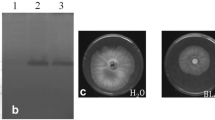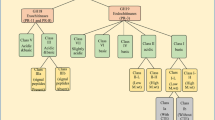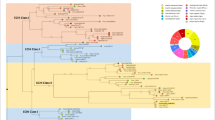Abstract
The role of the chitinolytic enzymes in plants is not necessarilyrestricted to plant defense. Tomato plants transformed with an endochitinaseand a chitobiosidase gene from Streptomyces albidoflavus andgrowth under greenhouse conditions showed a significant reduction in plantheight, and reduced time to flowering compared with the control(non-transformed) plants. The levels of chitobiosidase and endochitinaseactivity in the transgenic tomato plants were positively correlated with earlyflowering, and negatively correlated with plant height. We have not determinedwhether these effects are exclusively due to the expression of the transgenesof endochitinase and chitobiosidase from S. albidoflavus orthe additive effect of these 2 enzymes combined with the endogenouschitinolytic enzymes produced by the plants. However, when control plants were trimmed,early flowering was observed compared with the controls that were not trimmed, whichindicates that wound induced proteins such as chitinolytic enzymes affect thetime of flowering. In addition, the expression of the endochitinase andchitobiosidase genes significantly increased the number of flowers and fruit onthe plants, resulting in an increase in yield of fruit. One of the primarygoals of crop breeding programs is to increase the productivity of plants. These twogenes were directly associated with plant productivity, and should be studied further.
Similar content being viewed by others
References
Benhamou N. and Asselin A. 1989. Attempted localization of a substrate for chitinase in plant cell reveals abundant N-acetyl-D-glucosamine residues in secondary wall. Biol. Cell 67: 341-350.
Benhamou N., Joosten M. and De Wit J.G.M. 1990. Subcellular localization of chitinase and of its potential substrate in tomato root tissues infected by Fusarium oxysporum f. sp. radicis-lycopersici. Plant Physiol. 92: 1108-1120.
Boller T. 1987. Hydrolytic enzymes in plant disease resistance. In: Kosuge T. and Nestor E. (eds), Plant-Microbe Interaction. Vol. 2. Macmillan, New York, pp. 385-480.
Broekaert W.F., Van Parijs J., Allen A.K. and Peumans W.J. 1988. Comparison of some molecular, enzymatic and antifungal properties of chitinases from thorn-apple, tobacco and wheat. Physiol. Mol. Plant Pathol. 33: 319-331.
Broglie K., Chet I., Hollyday M., Cressman R., Biddle P., Knowlton S. et al. 1991. Transgenic plants with enhance resistance to the fungal pathogen Rhizoctonia solani. Science 245: 1194-1197.
Cheung W.Y., Hubert N. and Laundry B.S. 1993. A simple and rapid DNA microextraction method for plant, animal, and insect suitable for RAPD and other PCR analysis. PCR Meth. Appl. 3: 69-70.
Collinge D.B., Kragh K.M., Mikkelsen J.D., Nielsen K.K., Rasmussen U. and Vad K. 1993. Plant Chitinases. Plant J. 3: 31-40.
Cote F. and Hahn M.G. 1994. Oligosaccharides: structures and signal transduction. Plant Mol. Biol. 26: 1379-1411.
De Jong A.J., Cordewener J., Schiavo L.F., Terzi M., Vandekerckhove J., van Kammen A. et al. 1992. A carrot somatic embryo mutant is rescued by chitinase. Plant Cell 4: 425-433.
Dong J.K. and Dunstan D.I. 1997. Endochitinase and B-1,3-glucanase genes are developmentally regulated during somatic embryogenesis in Picea glauca. Planta 201: 189-194.
Flach J., Pilet P.E. and Jolles P. 1992. What's new in chitinase research? Experientia 48: 701-716.
Fulton T.M., Chunwongse J. and Tansksley S.D. 1995. Micropep protocole for extraction of DNA from tomato and other herbaceous plants. Plant Mol. Biol. Rep. 13: 207-209.
Gongora C.E., Wang S., Barbehenn R.V. and Broadway R.M. 2001. Chitinolytic enzymes from Streptomyces albidoflavus expresses in tomato plants: Effects on Trichoplusia ni (Lepidoptera: Noctuidae). Entomol. Exp. Appl. 99: 193-204.
Hammond K.K. and Jones J. 1996. Resistance gene-dependent plant defense responses. Plant Cell 8: 1773-1791.
Hanfrey C., Fife M. and Buchanan-Wollaston V. 1996. Leaf senescence in Brassica napus: expression of genes encoding pathogenesis-related proteins. Plant Mol. Biol. 30: 597-609.
Harikrishna K., Jampates B.R., Milligan S.B. and Gasser C.S. 1996. An endochitinase gene expressed at high levels in the stylar transmitting tissue of tomatoes. Plant Mol. Biol. 30: 899-911.
Heese-Peck A., Cole R.N., Borkhsenious O.N., Hart G.H. and Raikhel N.V. 1995. Plant nuclear pore complex proteins are modified by novel oligossacharides with terminal N-acetylglucosamine. Plant Cell 7: 1459-1471.
Hughes R.K. and Dickerson A.G. 1991. Modulation of elicitor-induced chitinase and b-1,3-glucanase activity by hormones in Phaseolus vulgaris. Plant Cell Physiol. 32: 853-861.
Karban R. and Myers J.H. 1989. Induce plant response to herbivory. Annu. Rev. Ecol. Syst. 20: 331-348.
Leung D.W. 1992. Involvement of plant chitinase in sexual reproduction of higuer plants. Phytochemistry 31: 1899-1900.
Lin W., Anuratha C.J., Datta K., Potrykus I., Muthukrishnan S. and Datta S.K. 1995. Genetic engineering of rice for resistance to sheath blight. Biotechnology 13: 686-691.
Mauch F., Mauch-Mani B. and Boller T. 1988. Antifungal hydrolases in pea tissue. II. Inhibition of fungal growth by combinations of chitinase and b-1,3-glucanses. Plant Physiol. 88: 936-942.
McCormick S., Niedermeyer J., Fry J., Barnason A., Horsch R. and Fraley R. 1986. Leaf disc transformation of cultivated tomato (L. esculentum) using Agrobacterium tumefaciens. Plant cell report 5: 81-84.
Neale A.D., Wahleithner J.A., Lund M., Bonnett H.T., Kelly A., Meeks-Wagner D.R. et al. 1990. Chitinase, b-1,3-glucanase, osmotin, and extensin are expressed in tobacco explants during flower formation. Plant Cell 2: 673-684.
Nishizawa Y., Nishio Z., Nakazono K., Soma M., Nakajima E., Ugaki M. et al. 1999. Enhanced resistance to blast (Magnaporthe grisea) in transgenic Japonica rice by constitutive expression of rice chitinase. TAG 99: 383-390.
Patil V.R. and Widholm J.M. 1997. Possible correlation between increased vigour and chitinase activity espression in tobacco. J. Exp. Bot. 48: 1943-1950.
Pierard D., Jacqmard A., Bernier J. and Salmon J. 1980. Appearance and disappearance of proteins in the shoot apical meristem of Sinapis alba in transition to flowering. Planta 150: 397-405.
Roberts W.K. and Selitrennikoff C.P. 1988. Plant and bacterial chitinases differ in antifungal activity. J. Gen. Micro. 134: 169-176.
Robinson S.P., Jacobs A.K. and Dry I.B. 1997. A class IV chitinase is highly expressed in grape berries during ripening. Plant Physiol. 114: 771-778.
Roby D. and Esquerre-Tugaye M.T. 1987. Induction of chitinases and of translatable mRNA for these enzymes in melon plants infected with Colletotrichum lagenarium. Plant Sci. 52: 175-185.
Schickler H. and Chet I. 1997. Heterologous chitinase gene expression to improve plant defense against phytopathogenic fungi. J. Industrial Microbiol. Biotechnol. 19: 196-201.
Schlumbaum A., Mauch F., Vogeli U. and Boller T. 1986. Plant chitinases are potent inhibitors of fungal growth. Nature 324: 365-367.
Sela-Buurlage M.B., Ponstein A.S., Bres-Vloemans S.A., Melchers L.S., Van den Elzen P.J. and Cornelissen B.J. 1993. Only specific tobacco (Nicotiana tabacum) chitinases and B-1,3-glucanases exhibit antifungal activity. Plant Physiol. 101: 857-863.
Spaink H.P., Wijfjes A.H., van Vilet T.B., Kijne L.W. and Lugtenberg J.J. 1993. Rhizobial lipo-oligosaccharide signals and their role in plant morphogenesis: are analogous lipophilic chitin derivatives produced by the plant? Aust. J. Plant Physiol. 20: 381-392.
Tabei Y., Kitade S., Nishizawa Y., Kikuchi N., Kayano T., Hibi T. et al. 1998. Transgenic cucumber plants harboring a rice chitinase gene exhibit enhance resistance to gray mold (Botrytis cinerea). Plant Cell Report 17: 159-164.
van Hengel A.J., Guzzo F., van Kammen A. and de Vries S. 1998. Expression pattern of the carrot EP3 endochitinase genes in suspension culture and in developing seeds. Plant Physiol. 117: 43-53.
Varner J.E. and Lin L.S. 1989. Plant cell wall architecture. Cell 56: 231-239.
Vogeli-Lange R., Frundt C., Hart C.M., Beffa R., Nagy F. and Meins F. 1994. Evidence for a role of B-1,3-glucanase in dicot seed germination. Plant J. 5: 273-278.
Vogelsang R. and Barz W. 1990. Elicitation of b-1,3-glucanase and chitinase activities in cell suspension cultures of Ascochyta rabiei resistant and susceptible cultivars of chickpea (Cicer arietinum). Z. Naturforsch. 45c: 233-239.
Wu S., Kriz A.L. and Widholm J.M. 1994. Molecular analysis of two cDNA clones encoding acidic class I chitinase in maize. Plant Physiol. 105: 1097-1105.
Xue B., Gonsalves C., Provvidenti R., Slightom J.L., Fuchs M. and Gonsalves D. 1994. Development of transgenic tomato expressing a high level of resistance to cucumber mosaic virus strains of subgroups I and II. Plant Dis. 78: 1038-1041.
Author information
Authors and Affiliations
Corresponding author
Rights and permissions
About this article
Cite this article
Gongora, C.E., Broadway, R.M. Plant growth and development influenced by transgenic insertion of bacterial chitinolytic enzymes. Molecular Breeding 9, 123–135 (2002). https://doi.org/10.1023/A:1026732124713
Issue Date:
DOI: https://doi.org/10.1023/A:1026732124713




